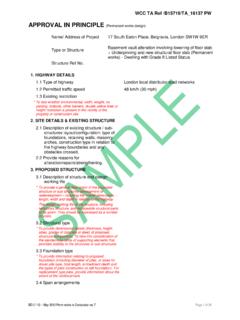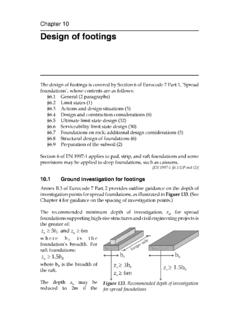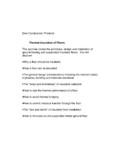Transcription of Foundation design for the Pentominium tower in …
1 Delivered by to:IP: : Wed, 22 Sep 2010 14:28:3125 CIVILengIneerIngKeywordsgeotechnical engineering; foundations ; piles & pilingdoi: of IceCivil engineering 162 November 2009 Pages 25 33 Paper 09-00036 The Pentominium tower in Dubai, UAe will be the tallest residential building in the world at over 100 storeys tall when completed in 2012. This paper describes the design of the tower s piled raft Foundation in the local carbonate soils and rock. Geotechnical investigations are outlined, along with how the effect of the proposed tower on neighbouring structures, single-pile response and impact of cyclic degradation were assessed. A description of the numerical analyses used to evaluate the overall piled raft response under various static and wind loading combinations is presented as well as some of the techniques used to optimise the Foundation design , including preliminary pile design for the Pentominium tower in Dubai, uAeKamiran IbrahimMSc, PhD is regional technical director at Hyder Consulting, Middle east, Dubai, UAeGrahame BunceMSc, CEng, MICE is technical director at Hyder Consulting (UK) Ltd, Guildford, UKCatherine MurrellsMA, MEng, CEng, MICE is principal geotechnical engineer at Hyder Consulting (UK)
2 Ltd, Guildford, UKThe Pentominium residential development is located approximately 500 m to the east of Dubai Marina and south of the beach near the Jumeira Palm in the United Arab Emirates (UAE) (Figure 1). The development comprises the construction of a tower over 100 storeys tall m0200 BeachDubai internationalMarine ClubMetropolitanClubForte Grand HotelDubai MarinaAmerican CollegeSheik Zayed RoadPentominiumtowerMarina23 towerFigure 1. Location of the Pentominium tower on the Dubai waterfrontDelivered by to:IP: : Wed, 22 Sep 2010 14:28:3126PR oCeeDINGS oF THe INSTITUTIoN oF CIVIL eNGINeeRS CIVILENGINEERING, 2009, 162, No. Ce6 ISSN 0965 089 XIBRAHIM, BUNCe AND MURReLLSand associated podium structure (Figure 2). It is set to be the tallest residential building in the world when completed in 2012.
3 All site levels are related to Dubai Municipal-ity datum (DMD) and original ground level is at about 5 m DMD. There are six basement levels and the structure is supported by a piled raft system comprising large-diameter bored piles cast in situ. The pile cut-off levels are founded about 24 m below existing ground level at an elevation of m area of the site is very limited with the structure extending to all boundaries. In addi-tion, construction on the adjacent Marina 23 tower is underway, with a number of levels of superstructure completed before piling started on the Pentominium tower in client for the project is Trident Inter-national Holdings and the architect is Aedas. Hyder Consulting carried out the detailed design of the Foundation , substructure and superstruc-ture.
4 Arab Centre for Engineer Studies (ACES) carried out the ground investigation and Swiss-boring Limited was the piling geology of the UAE and the Persian Gulf area has been substantially influenced by the deposition of marine sediments associ-ated with numerous sea level changes during relatively recent geological times. With the exception of mountainous regions shared with Oman in the north-east, the country is relatively low-lying, with near-surface geol-ogy dominated by deposits of Quaternary to late Pleistocene age, including mobile Aeolian dune sands, sabka/evaporite deposits and marine is situated towards the eastern extrem-ity of the geologically stable Arabian tectonic plate and is separated from the unstable Iranian fold belt to the north by the Persian Gulf.
5 It is therefore considered that the site is located within a moderately seismically active area. However, it was indicated from the structural analysis that the wind effect was more critical than the seismic effect as is typical for structures of this size in investigation and testingThe ground investigation was undertaken by ACES and consisted of sinking eight cable percussion boreholes with rotary follow-on methods, in-situ testing and laboratory testing (including specialist testing) on selected sam-ples. The boreholes were drilled to 80 125 m deep with standpipe piezometers installed to monitor the groundwater table. The scope of in-situ testing is summarised as followsn standard penetration testingn packer permeability testingn pressuremeter testing at 3 m intervals in three of the boreholesn geophysics (cross-hole, cross-hole tomog-raphy and down-hole testing).
6 Disturbed, undisturbed and split-spoon samples were obtained from the boreholes for laboratory testing purposes. The undisturbed samples were obtained using double-tube-core barrels from which 92 mm nominal core Figure 2. Artist s impression of the Pentominium tower , which, at over 100 storeys tall, will be the highest residential building in the world when completed in 2012+10metres DMDBH06BH03BH02Ve ry loose to loose sandMedium dense to very dense sandVe ry dense silty sand with sand stone fragmentsSandstoneSandstoneCalcisiltiteI nterbedded siltstone and gypsumAssumed geological unit basedon existing boreholesGypsiferous sandstoneCalcisiltite/conglomerate/congl omeritic calcisiltite+50 5 10 15 20 25 30 35 40 45 50 55 60 65 70 75 80 85 90 95 100 105 110 115 120 Base of borehole dataGroundwater strikeFigure 3.
7 Geological long-section through three of the boreholesDelivered by to:IP: : Wed, 22 Sep 2010 14:28:3127 ISSN 0965 089 X PR oCeeDINGS oF THe INSTITUTIoN oF CIVIL eNGINeeRS CIVILENGINEERING, 2009, 162, No. Ce6 Foundation design FoR THe Pentominium tower IN DUBAI, UAediameters were recovered. The laboratory testing included the following standard and specialist testsn standard classification testingn chemical testingn unconfined compression testsn cyclic undrained triaxialn cyclic simple shearn stress path triaxial testingn resonant columnn constant normal stiffness standard ground investigation testing was carried out following British standards BS 59301 and BS preliminary trial pile tests were also carried out to determine single-pile load settlement behaviour and to assess the pile capacity in skin conditions and parametersThe ground conditions comprise a horizon-tally stratified sub-surface profile.
8 Three layers of sand, varying from very loose to medium dense to dense as elevation decreases, overlie layers of very weak to weak sandstone, gyp-siferous sandstone, calcisiltite, conglomerates and calcareous siltstones. An idealised ground profile used for the whole site is presented in Table 1 and a sec-tion through three of the boreholes is shown in Figure geotechnical stiffness parameters for the design of the Foundation were determined from the tests carried out on the strata at dif-ferent strain levels. It is presented in Mayne and Schneider3 that rock behaviour for defor-mation analyses, which would include piled rafts, ranges between strain values of approxi-mately , which correlate with testing results from the pressuremeter, stress path triaxial, resonant column, cyclic triaxial testing and geophysics which are presented on Figure 4.
9 It should be noted that the design line shown on Figure 4 is for small strain design at strain. The stiffness values provided in Table 1 are for the larger strain levels of approximately 1% determined from standard correlations with unconfined compressive strength results as presented in Tomlinson and Woodward:4 drained Young s modulus at large strain E' = Mr j qu, where Mr is the ratio of elastic modulus of intact rock to its uniaxial compressive strength, j is the mass factor and qu is the uniaxial compressive stress strain curves were devel-oped for the rock strata based on all the ground investigation data. The curves were fitted to the data using hyperbolic functions as presented by Mayne and Schneider3 and are 35 30 25 20 15 10 50 Pressuremeter initialPressuremeter reload 2 Stress path column valuesrelate to the levelof strain at whichthe samples aretestedPressuremeter reload 1 Cyclic triaxial geophysicsStrataDesign line at small strain 75 70 65 60 55 50 45 40 115 110 125010002000300040005000 120 105 100 95 90 85 80 Elevation : m DMDE lasticity modulus: MPaStress path 4.
10 Young s modulus E' values derived from geotechnical testingTable 1. Idealised ground profile and geotechnical parametersstrata numbersub-strata numberMateriallevel at top of stratum: m dMdThickness: munconfined compressive strength: Mpaundrained modulus* Eu: Mpadrained modulus* E': Mpa11aVery loose to loose slightly silty sand with occasional sandy silt+ to + 21bMedium dense to very dense slightly silty to silty sand to + 361cVery dense silty sand with sandstone fragments 7522 Very weak to weak calcarenite/calcareous sandstone interbedded with cemented sand weak to weak gypsiferous sandstone weak to moderately strong calcisiltite/conglomerate/conglomeritic calcisiltite sandstone weak to moderately strong calcisiltite weak to moderately weak claystone/siltstone interbedded with gypsum layers > (proven to base of boreholes) * Note that Eu and E' values relate to large strain level (about 1%) of the strataDelivered by to:IP: : Wed, 22 Sep 2010 14:28.





